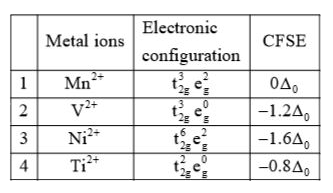An ion M2+ forms the complexes. [M(H2O)6]2+ [M(en)3]2+ [MBr6]4−
Match the complex with the appropriate colour respectively :
Green, blue and red
Blue, red and green
Green, red and blue
Red, blue and green
The correct Answer is:B
To solve the problem of matching the complexes with their respective colors, we will follow these steps:
Step 1: Identify the complexes and their ligands
The complexes given are:
1. (M(H2O)6)2+
2. (M(en)3)2+
3. (MBr6)4−
The ligands in these complexes are:
- H2O (water) - a weak field ligand
- en (ethylenediamine) - a strong field ligand
- Br− (bromide) - a weak field ligand
Step 2: Determine the field strength of the ligands
- Weak field ligands (like H2O and Br−) typically produce larger splitting of the d-orbitals, resulting in higher energy transitions and longer wavelengths of light absorbed.
- Strong field ligands (like en) produce smaller splitting of the d-orbitals, resulting in lower energy transitions and shorter wavelengths of light absorbed.
Step 3: Analyze the color emitted by each complex
- For (M(H2O)6)2+: As a weak field ligand, it absorbs light in the green region of the spectrum, thus it emits red light.
- For (M(en)3)2+: As a strong field ligand, it absorbs light in the red region, thus it emits green light.
- For (MBr6)4−: As a weak field ligand, it absorbs light in the orange region, thus it emits blue light.
Step 4: Match the complexes with their respective colors
Based on the analysis:
1. (M(H2O)6)2+ emits red light.
2. (M(en)3)2+ emits green light.
3. (MBr6)4− emits blue light.
Final Matching
- (M(H2O)6)2+ → Red
- (M(en)3)2+ → Green
- (MBr6)4− → Blue
Summary of the solution:
- (M(H2O)6)2+ → Red
- (M(en)3)2+ → Green
- (MBr6)4− → Blue
The complexes given are:
1. (M(H2O)6)2+
2. (M(en)3)2+
3. (MBr6)4−
- H2O (water) - a weak field ligand
- en (ethylenediamine) - a strong field ligand
- Br− (bromide) - a weak field ligand
- Weak field ligands (like H2O and Br−) typically produce larger splitting of the d-orbitals, resulting in higher energy transitions and longer wavelengths of light absorbed.
- Strong field ligands (like en) produce smaller splitting of the d-orbitals, resulting in lower energy transitions and shorter wavelengths of light absorbed.
- For (M(H2O)6)2+: As a weak field ligand, it absorbs light in the green region of the spectrum, thus it emits red light.
- For (M(en)3)2+: As a strong field ligand, it absorbs light in the red region, thus it emits green light.
- For (MBr6)4−: As a weak field ligand, it absorbs light in the orange region, thus it emits blue light.
Based on the analysis:
1. (M(H2O)6)2+ emits red light.
2. (M(en)3)2+ emits green light.
3. (MBr6)4− emits blue light.
- (M(H2O)6)2+ → Red
- (M(en)3)2+ → Green
- (MBr6)4− → Blue
- (M(H2O)6)2+ → Red
- (M(en)3)2+ → Green
- (MBr6)4− → Blue
Topper's Solved these Questions
- BOOK - GRB PUBLICATIONCHAPTER - COORDINATION COMPOUNDSEXERCISE - F.Isomerism in Coordination Compounds124videos
COORDINATION COMPOUNDS
- BOOK - GRB PUBLICATIONCHAPTER - COORDINATION COMPOUNDSEXERCISE - G. Organometallic Compounds, Synergic Bonding52videos
COORDINATION COMPOUNDS
- BOOK - GRB PUBLICATIONCHAPTER - COORDINATION COMPOUNDSEXERCISE - D.VBT, CFT, Hybridisation123videos
COORDINATION COMPOUNDS
- BOOK - GRB PUBLICATIONCHAPTER - CHEMICAL KINETICSEXERCISE - Subjective Type63videos
CHEMICAL KINETICS
- BOOK - GRB PUBLICATIONCHAPTER - D-BLOCK ELEMENTSEXERCISE - Subjective Type18videos
D-BLOCK ELEMENTS
Similar Questions
Knowledge Check
- Question 1 - Select One
An ion M2+, forms the complexes [M(H2O)6]2+,[M(en)3]2+and[MBr6]4−, match the complex with the appropriate colour:
AGreen, blue and redBBlue, and greennCGreen, red and blueDRed, blue and green - Question 2 - Select One
Given that the energy of the photons of different colours decreases in the order of VIBGYOR (Violet > Indigo > Blue > Green > Yellow > Red ) and that if complex absorbs a photon of low energy then it shows colour of high energy photon. If an ion , M2+, forms the complexes [M(H2O)6]2+,[MBr6]4−,and[M(en)3]2+. The colours of the complexes, though not necessarily in order, are green, red, and blue. Match the complexes with the appropriate colour. ( Do not use the table of complementry colours for this question )
A[MBr6]4−blue,[M(H2O)6]2+green,[M(en)3]2+redB[MBr6]4−green,[M(H2O)6]2+blue,[M(en)3]2+redC[MBr6]4−green,[M(H2O)6]2+red,[M(en)3]2+blueD[MBr6]4−red,[M(H2O)6]2+green,[M(en)3]2+blue - Question 3 - Select One
The magnetic moment of the complex [Ti(H2O)6]3+ is
A3.87BMB1.73BMC2.84BMD5.87BM
[Co(H2O)6]3+ complex is
View SolutionThe magentic momentsn(BM) of the complexes [Ni(H2O)6]2+ and [Ni(NH3)6]2+ are resectively
View SolutionIn the complex [Fe(H2O)6]3+ [Fe(CN)6]3− [Fe(C2O4)3]3− and [FeCl6]3−, that complex that has highest stability is
View SolutionChoose the correct statement for the complex [Al(H2O)6]3+ :
View SolutionChoose the correct statement for the complex [Al(H2O)6]3+ :
View Solution


